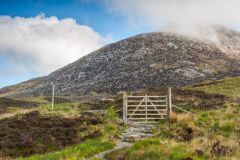
Goatfell (or 'Goat Fell' depending on your spelling preferences) is the highest peak on Arran, at 874 metres (2,866 feet). If you're a keen mountaineer that means it is almost a 'Munro' (peak over 3000 feet), but not quite! Paths lead to the summit of Goatfell from Brodick Castle and country park, and from the spectacular Glen Rosa. The fell and surrounding countryside are managed by the National Trust for Scotland.
There are a multitude of fascinating historic bits and bobs on the slopes of Goatfell, including standing stones and ruined 18th-century shielings. Wildlife abounds on Goatfell; look for ptarmigan and hen harriers. Near the summit you can spot dwarf junipers, and dwarf willow; the smallest willow in Britain, which reaches just 5cm in height.
This is one of the most popular climbs in Scotland, and it is easy to see why, for though it is not difficult, the reward for your exertion is spectacular views over the surrounding knife-edge ridges, and over Arran itself and as far as Ireland if the weather is clear. The National Trust for Scotland describes the ascent of Goatfell as moderate, and if you are reasonably fit you will have no trouble at all making the climb.
From the car park to the summit is 6.5 miles (about 10.5 km). If you take an OS map, which I always advise, you'll need the Landranger 69. Plan on allowing 4-5 hours for the return trip. Also, plan on sudden changes in weather! The last time I climbed Goatfell it was shrouded in mist all the way up, and though the sun made a few very brief appearances, it was only after I'd made it back down that the sky magically cleared and left the summit bathed in sunshine.

The last 200 metres are the toughest part of the climb, and this is where you need to take care if the mist descends - as it is prone to do - and obscures visibility. However, all those warnings aside, it is a glorious walk, and well worth the exertion to reach the top. There is a trig point on top, with a map showing direction and distance to notable points on the horizon. Look for old graffiti carved into the rocks at the summit, including a memorial to the mariners of the HMS Vixen.
The most popular route up Goatfell starts from the Cladach Visitor Centre, but you can also start from Brodick itself if you want a longer route. From Cladach the rail passes through woodland, skirting the Brodick Castle grounds. The connection with the castle and the surrounding estate goes much deeper, however, for the mountain and castle were both parts of the same large estate. In 1958 Lady Jean Fforde gave the castle and Goatfell to the nation. The castle parkland and grounds formed the basis for the country park that gives access to Goatfell and the surrounding countryside.
Murder on the Mountain
Goatfell is an unusual place for a dramatic crime to take place, but that's just what happened in 1889. John Laurie was accused of murdering Edwin Rose on the mountain. Laurie protested his innocence, though he did admit to robbing Rose. Despite his steadfast claims of innocence, Laurie was convicted of the murder. He was sentenced to death, although this was later commuted to life imprisonment.
More tragedy followed in World war Two, when 6 military planes crashed on Goatfell and the neighbouring peak of Beinn Nuis, costing 51 servicemen their lives.
About Goatfell
Address: Brodick,
Isle of Arran,
Arran,
Ayrshire,
Scotland, KA27 8HY
Attraction Type: Countryside
Location: Access from Brodick Country Park or from Cladach on the A841
Website: Goatfell
National Trust for Scotland
Location
map
OS: NR991 415
Photo Credit: David Ross and Britain Express
Opening Details: Open access site, usually accessible at any reasonable time
POPULAR POSTS
HERITAGE
 We've 'tagged' this attraction information to help you find related historic attractions and learn more about major time periods mentioned.
We've 'tagged' this attraction information to help you find related historic attractions and learn more about major time periods mentioned.
Find other attractions tagged with:
18th century (Time Period) - castle (Architecture) -
NEARBY HISTORIC ATTRACTIONS
Heritage Rated from 1- 5 (low to exceptional) on historic interest
Glen Rosa Waterfall Walk - 1.7 miles (Countryside) ![]()
Brodick Castle - 2.7 miles (Historic House) ![]()
Arran Heritage Museum - 3.2 miles (Museum) ![]()
North Glen Sannox Waterfall Walk - 3.3 miles (Countryside) ![]()
Coire Fhionn Lochan - 6.2 miles (Countryside) ![]()
Lochranza Castle - 6.8 miles (Castle) ![]()
Auchencar Druid Standing Stone - 7 miles (Prehistoric Site) ![]()
Auchagallon Stone Circle - 7.4 miles (Prehistoric Site) ![]()
Nearest Holiday Cottages to Goatfell:
Nearby accommodation is calculated 'as the crow flies' from Goatfell. 'Nearest' may involve a long drive up and down glens or, if you are near the coast, may include a ferry ride! Please check the property map to make sure the location is right for you.
More self catering near Goatfell









